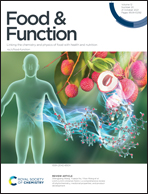Identification and characterization of Crassostrea angulata arginine kinase, a novel allergen that causes cross-reactivity among shellfish†
Abstract
Oyster is a common food that causes allergy. However, little information is available about its allergens and cross-reactivity. In this study, arginine kinase (AK) was identified as a novel allergen in Crassostrea angulata. The primary sequence of AK was cloned which encoded 350 amino acids, and recombinant AK (rAK) was obtained. The immunodot results, secondary structure and digestive stability showed that native AK and rAK had similar IgG/IgE-binding activity and physicochemical properties. Serological analysis of 14 oyster-sensitive individuals demonstrated that AK exhibited cross-reactivity among oysters, shrimps, and crabs. Furthermore, nine epitopes in oyster AK were verified using inhibition dot blots and inhibition enzyme linked immunosorbent assay, six of which were similar to the epitopes of shrimp/crab AK. The most conserved epitopes were P5 (121–133) and P6 (133–146), which may be responsible for the cross-reactivity caused by AK. These findings will provide a deeper understanding of oyster allergens and cross-reactivity among shellfish.



 Please wait while we load your content...
Please wait while we load your content...